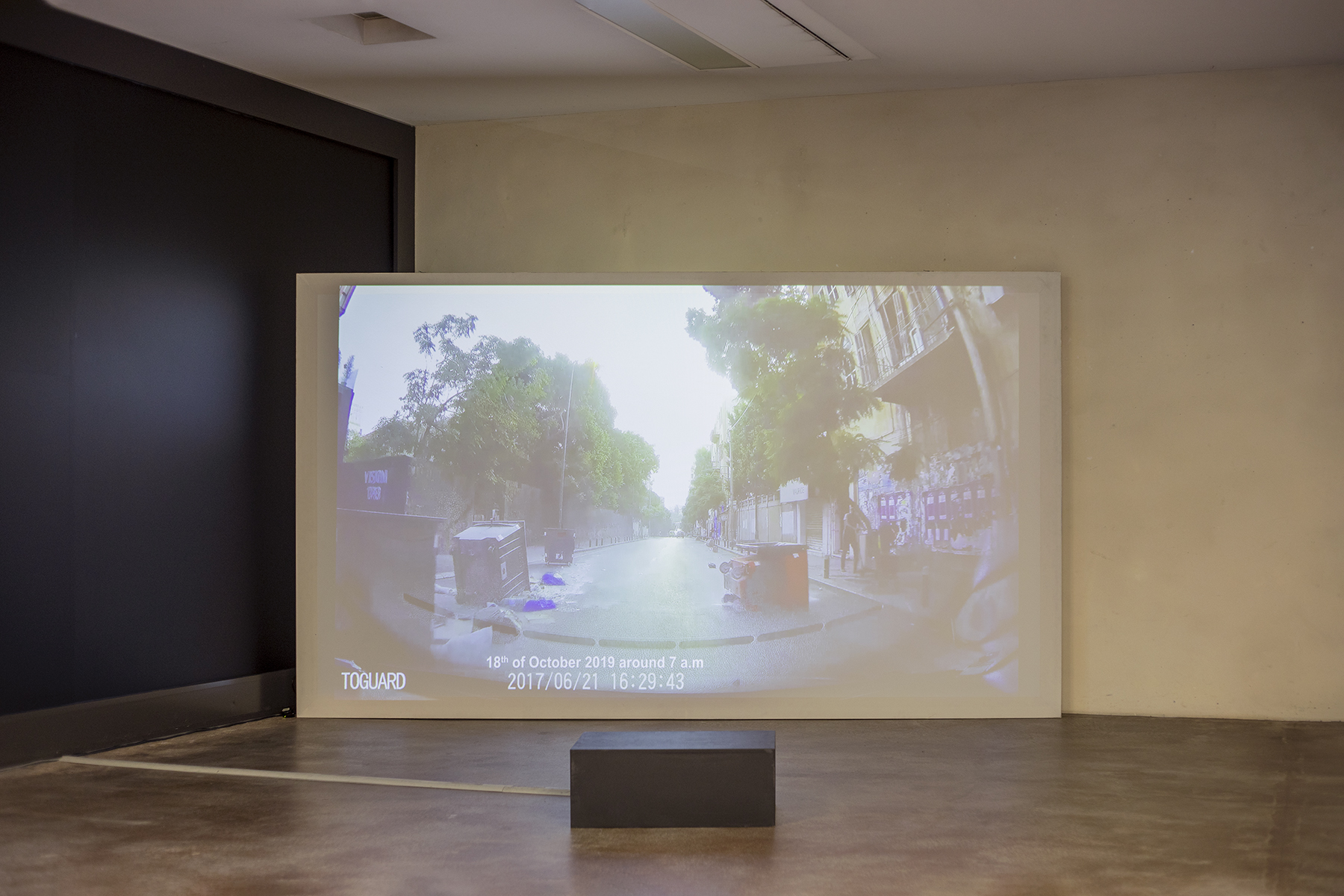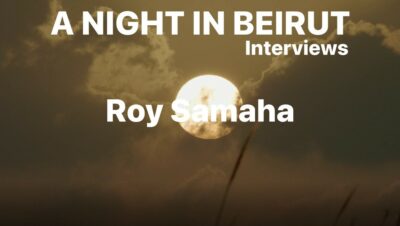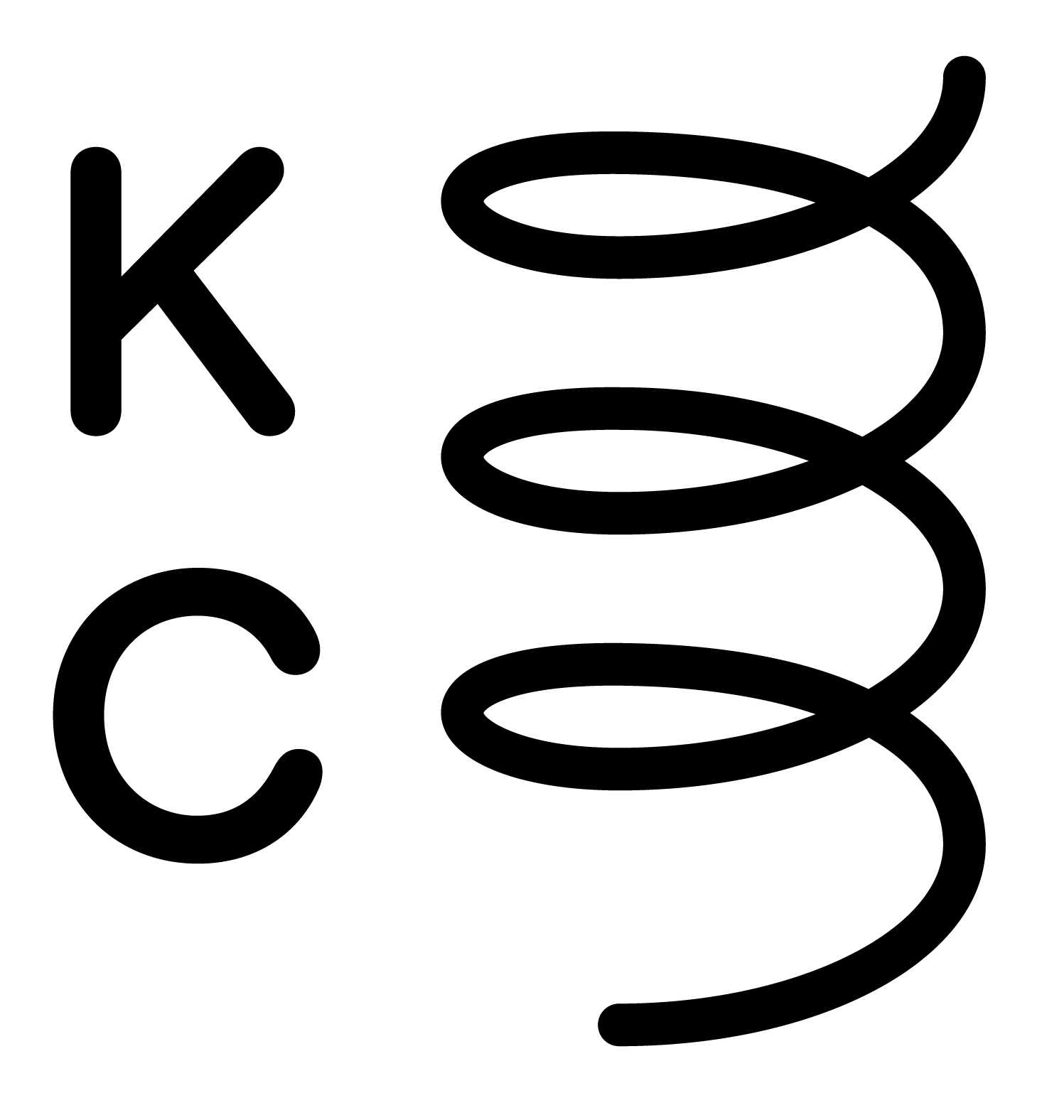

A Night in Beirut – Film programme
28 January 2022 – 27 March 2022
A Night in Beirut – Interviews
Stéphanie Saadé in conversation with the Libanese artists:

Download text here: Stephanie Saade in conversation with Roy Samaha
A Night in Beirut
SIRINE FATTOUH, STÉPHANIE DADOUR, MARWAN MOUJAES, ROY SAMAHA and MAHA YAMMINE
28.1-27.3.2022
Parallel to her solo exhibition Building a Home with Time, Stéphanie Saadé is putting together a programme of films by Lebanese artists entitled A Night in Beirut[1]. Sirine Fattouh and Stéphanie Dadour, Marwan Moujaes, Roy Samaha and Maha Yammine have been invited to show a selection of their films, arranged in a weekly programme.
Each of their voices is unique and offers a particular vision of Lebanon and of their experience of the country: a car that criss-crosses the roads and probes landscapes, situations and daily life for Sirine Fattouh and Stéphanie Dadour; tableau-films that offer a view of landscapes and territories, through which the socio-political reality of the country shines through for Marwan Moujaes; a character launched into a historical research that unexpectedly leads to a quest for self-discovery for Roy Samaha; performative actions, learned in the past and awkwardly replayed years later for Maha Yammine. The films all bear witness in their own way to a collective memory of Lebanon, past or very recent, and in this way create an active dialogue with the works in Stéphanie Saadé’s exhibition.
WEDNESDAYS: MAHA YAMMINE
14, 2017, video, 80′, courtesy the artist
In 14 (2017) Maha Yammine films a group of amateur card players. Although the artist does not intervene at any point in the game, she has edited the game beforehand by erasing the different characteristics of the cards, such as the colours and numbers. Using their imagination and experience, the players have to invent their own games. By getting rid of the rules and chance – elements that normally constitute card games – Yammine wishes to highlight the essential aspects of this practice: conviviality and proximity, by offering players a space free of the usual conventions.
Moussa, 2017, video, 80′, courtesy the artist
In Moussa (2017), Maha Yammine asks a man, Moussa, to make a dress in front of the camera, a gesture that used to be part of his daily life for a decade; as a child, he was already involved in the family business that made clothes for little girls. Forty-two years later, Moussa accepts the challenge of making a dress for the first time after this activity has ceased. We observe his body and mind busy remembering the steps and gestures necessary to make a dress, acts that were once performed with ease and without hesitation.
Fanfare, 2017, video, 5′, courtesy the artist
The approach chosen by Maha Yammine for Fanfare (2017) is comparable to that of Moussa. Towards the beginning of the Lebanese civil war, a group of young people found themselves without activity. These teenagers formed a fanfare and played music in the festive occasions of the village and neighbouring villages. The artist asked a married couple, who met each other in the fanfare, to re-play a piece of music for the first time since the interruption of their musical activity, in front of the camera, without any training or rehearsal.
THURSDAYS: ROY SAMAHA
Sun Rave, 2019, video loop, 11′, courtesy the artist
Speculating on the impact of a 1989 solar storm, Roy Samaha’s film Sun Rave (2019) mimics the unpredictable release of energy flares, layering personal histories with major geopolitical events as it shifts from his family’s Beirut home to Bucharest, Berlin, and further afield.
Landscape at Noon, 2014-2016, HD colour video, stereo sound, 66′, courtesy the artist
Screening at 5.30 pm and 6.45 pm
Roy Samaha’s feature film Landscape at noon (2014-2016) follows a character on a historical quest that leads to an existential quest. Nasri is a young filmmaker who is working on his latest feature film, set during the Lebanese civil war, but he feels that his reconstructed scenes look fake; he is unable to represent death. Despite researching photographic and video archives from the war, he is obsessed with the idea that there is an element of truth missing. Feeling at a loss, Nasri decides to go on a research trip to Cyprus, but the journey will take an unexpected turn.
FRIDAYS: SIRINE FATTOUH AND STÉPHANIE DADOUR
From Syria to Palestine: El Autostrad’, 2017, video loop, 240′, courtesy the artists.
In From Syria to Palestine: El Autostrad’ (2017), Stéphanie Dadour and Sirine Fattouh drive through Lebanon, represented as a space linking the Lebanese-Syrian border in the north to the Lebanese-Palestinian border in the south. The autostrada reveals a landscape and tells the story of the making of a nation. It is at the same time a Lebanon as a residual space and a Lebanon that is too full. The journey takes place in one attempt, following the rhythm of a typical day. It takes a little over 200 km or 4 hours without traffic, to discover a set of places linked by a road, a landscape receptacle of multiple structures. Dadour and Fattouh film this territory with two cameras placed on the front and side of the vehicle, thus recording tableau films that offer a glimpse of daily life, through which the socio-political realities of the country emerge.
SATURDAYS: MARWAN MOUJAES
40 days of mourning, 2016, video loop, 4′, courtesy the artist and NASA/SDO, the AIA, EVE and HMI science teams
On August 21, 2013, at 3:15 am, a chemical attack on Gotha in Syria produced between 322 and 1729 victims. 40 days of mourning (2016) gathers all the images of the sun taken by the NASA’s Solar Dynamics Observatory between August 21st, 2013 at 3:15 and October 3rd at 3:15, 40 days after the attack. 40 days, the time needed for mourning, before the body decomposes and the soul leaves the body completely.
Counting Sheep, 2018, video loop, 6′, courtesy the artist
In Counting Sheep (2018) a flock of sheep is rocked by the music of a bedtime lullaby and grazes along the bank of the Litani River, the border of the occupied then demilitarised zone of South Lebanon. These different elements – which symbolically refer to peaceful sleep or reverie – are threatened by the extremely volatile socio-political context of the place. Which will show up first: a dream or a war?
Before Tomorrow Was Not Today, 2021, video loop, 17′, courtesy the artist
Before Tomorrow Was Not Today (2021) was filmed shortly before midnight on December 31st 2018, while waiting for the first hours of 2019. The video – located between two years – is read backwards. The fireworks and fire shots emerging out of Beirut’s skyline fall onto it and are inhaled by the city. An ambiguous scene of celebration, invasion and civil war.
SUNDAYS: SIRINE FATTOUH
Behind the Shield (2019 – ongoing), video loop, 55′, courtesy the artist and AD Leb (Art Design Lebanon)
Behind the Shield (2019 – ongoing ) is an hour-long video that paints a filmic portrait of the city of Beirut over the past three years. The work documents key moments in the country’s recent history – from the October Revolution in 2019 to the port explosion of August 4th 2020 – while also shedding light on the mundane and commonplace facets of everyday life.
Curator of the exhibition
Stéphanie Saadé, artist
#aristtakeover – Instagram takeovers
An artist takes over the Instagram account of Kunsthaus Pasquart (@pasquart_) for 24 hours and uses it to show their own artistic creativity, the working process in the studio or new pieces; to focus on materials or methods or to share their reflections. The artist is free to choose the content. The format offers a lively and more personal perspective for the audience to experience an artist’s practice. For the artists, it provides a means to present their work independently of a physical location and to curate it themselves.
13.2.2022 Sirine Fattouh
27.2.2022 Marwan Moujaes
20.2.2022 Maha Yammine
6.3.2022 Roy Samaha
20.3.2022 Stéphanie Saadé
[1] Based on the title of a film by Sirine Fattouh.

